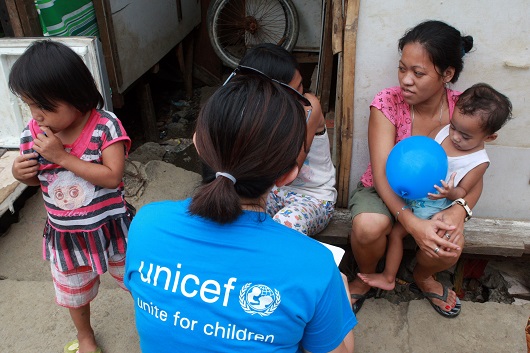UNICEF Sends Aid for Typhoon Victims in Philippines
 The United Nations Children’s Fund (UNICEF) launched a $2.8 million appeal to help children affected by Typhoon Koppu which recently tore through the Philippines.
The United Nations Children’s Fund (UNICEF) launched a $2.8 million appeal to help children affected by Typhoon Koppu which recently tore through the Philippines.
“Typhoon Koppu’s slow moving path includes mountainous and hard-to-reach areas, and we are concerned about the wellbeing of all affect children,” UNICEF Philippines Representative Lotta Sylwander said.
Days before Typhoon Koppu hit, UNICEF activated its emergency preparedness measures via its Disaster Risk Reduction (DRR) plan. The DRR is a systematic approach that assesses and reduces risk before, during and after a disaster.
UNICEF collaborated with the Philippine government in the pre-emptive evacuation plan which minimized casualties and property damage.
Mike Bruce, a spokesperson for Plan International, said the typhoon hit many poor communities that would struggle to rebuild their livelihoods without assistance.
“UNICEF’s first priority is to ensure children are safe and protected. Following a typhoon, children face risks from contaminated water sources, lack of food, epidemics such as cholera, hypothermia, diarrhea and pneumonia,” said Sylwander.
Save the Children estimates that 4.5 million children could be affected. In addition to restoring a safe water supply for families in the evacuation centers, UNICEF will include nutritional aid for breastfeeding mothers.
Typhoon Koppu caused floods, landslides, power outages and damaged roads and bridges, consequently isolating several towns and villages. However, the Philippines disaster agency said they have evacuated more than 65,000 people from low-lying and landslide-prone areas.
UNICEF has provided about 12,000 families with water purification tablets, hygiene kits, medicines, schools supplies, food, tents and generators.
“Secondly, we must ensure that the rhythm of children’s lives are restored and that they get back to school as soon as possible,” continued Sylwander.
DRR is also working in collaboration with Save the Children, Plan, World Vision and the Institute for Development Studies to ensure that policies recognize child safety.
Save the Children’s Country Director in the Philippines, Ned Olney, said, “From our own experience responding to other storms in the Philippines we know that children are always the most vulnerable in a disaster, in the coming days we will determine what support they will need.”
Many poor communities were destroyed many typhoon victims are attempting to return to their villages to salvage as much as possible.
UNICEF will conduct an assessment of the destruction of banana, coconut, rice and corn plantations in the most affected areas to estimate the extent of the needs of the typhoon victims. The assessment will also determine the damage done to education facilities and what will be needed to restore them as soon as possible.
– Marie Helene Ngom
Sources: Huffington Post, UNICEF 1, UNICEF 2
Photo: Flickr
